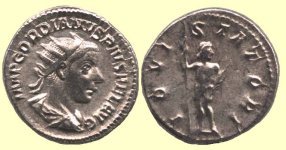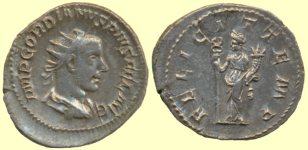
Gordian III 238 - 244 A.D.
By clicking on the pictures you'll be linked to a more complete description of the coin. At the bottom of this page there is a more elaborate biography of the emperor.
 |
Obverse: IMP GORDIANVS PIVS FEL AVG |
| Reverse: IOVI STATORI | |
|
Fieldmarks: -
|
|
| Exergue: - |
 |
Obverse: IMP GORDIANVS PIVS FEL AVG |
| Reverse: FELICIT TEMP | |
|
Fieldmarks: -
|
|
| Exergue: - |
Gordian III 238 - 244 A.D.
Marcus Antonius Gordianus (Gordian III) was born in Rome on the 20th of January 225. His mother was the daughter of the senator Marcus Antonius Gordianus Sempronianus Romanus (Gordian I). His father was undoubtedly a senator, but his name is not known. In April of 238 Rome was under serious threat of attack by the usurper Maximinus and to continue the failed rebellion started by Gordian I and II the senate had to quickly appoint a new emperor. They declared two of their own, namely Balbinus and Pupienus (who was quite unpopular because of his recent Prefecture of the city (Praefectus Urbis)), as new emperors. When the people heard of these elections riots broke out and they demanded a Gordianus on the throne. To appease the people the now 13-year-old Gordian was brought from his home, named Marcus Antonius Gordianus after his grandfather, and proclaimed Caesar and imperial heir by the senate. Later that year all the existing tensions between the two emperors the people and the military came to a head when soldiers of the praetorian guard stormed into the imperial palace, and captured and killed both Pupienus and Balbinus. Gordian, who had already received the title of Caesar, was the only person that occurred to the soldiers as proper to fill the vacant throne. He was also very popular amongst the people and his tender age promised a long impunity of military license, the soldiers lifted him up on a shield to be cheered by the jubilant people of Rome. They carried him to their camp, and unanimously saluted him Augustus.
There is almost no reliable information about the first few years of Gordian III's reign. Immediately after his accession, he fell into the hands of his mother's eunuchs, who completely controlled him. In 240, an uprising originated in the province of Africa, with the proconsul Sabinianus being proclaimed emperor, this uprising however was quickly suppressed by troops send from Mauretania. In late 240 or early 241, Gordian III broke free from the control and manipulation of the eunuchs and appointed Timesitheus as praetorian prefect. Timesitheus, who was of Eastern origin, had a long career in the imperial service as a procurator in several provinces. Timesitheus' proven abilities quickly made him the central figure in Gordian III's government, and the praetorian prefect's authority was enhanced by the marriage of his daughter, Furia Sabinia Tranquillina, to the young emperor in the summer of 241. Maintaining security along the frontiers remained the emperor's most serious challenge difficulties along the Danube where common, but the greater danger was in the East. Namely the aggressive expansion of the renewed Persian empire under the Sassanian emperor Ardashir I which was continued under his son and successor, Shapur I. The focus of that expansion was upper Mesopotamia, much of which had been under direct Roman control for more than a generation. During this year Hatra, the location of Rome's easternmost military garrison, was captured by the Sassanians and Antioch came under siege. Plans for a massive Roman military counterattack were soon underway and Timesitheus convinced Gordian III to leave the luxury of Rome and to join his troops on this military campaign. Under the command of Timesitheus the Romans managed to free Antioch which they immediately strengthened. Also Carrhae and Nisibis were retaken, and the Romans won a decisive victory over the Persians at Resaina. But during the winter of 243 the emperor's father-in-law and mentor, Timesitheus, died of an illness but not without a very strong suspicion of poison. The surviving praetorian prefect, C. Julius Priscus, convinced the emperor to appoint his brother M. Julius Philippus (later Philip the Arab) as Timesitheus' successor. The campaign against the Sassanians continued as the Roman army proceeded to march down the Euphrates during the fall and early winter. Early in 244, the Roman and Sassanide armies met near the city of Misiche. Shapur's forces were triumphant, and the city was renamed Peroz-Shapur, "Victorious [is] Shapur."
Soon thereafter in February of 244 Gordian III was killed near Circesium, along the Euphrates some 250 miles upstream of Peroz-Shapur. Philip is universally blamed for causing Gordian III's death, either directly or by creating discontent with the emperor by cutting off the troops' supplies (and blaming the lack of supplies on Gordian's inexperience and youth). Philip, who was proclaimed Gordian III's successor by the army, reported to the senate that the 19-year-old emperor had died of natural causes. Gordian III's Persian campaigns were promoted within the Roman Empire as a success and Gordian III was deified. Other than the loss of Hatra, the Sassanides gained no additional territory and Shapur did not disturb Roman interests in upper Mesopotamia for nearly eight years. The positive portrayal Gordians reign received was reinforced by the negative portrayal of his successor, Philip. The lack of information about Gordian III's reign makes it difficult to know whether the young emperor truly lived up to such an ideal, but the historical tradition gives one the suspicion that perhaps he did.
For a huge collection of Gordian III coins look here
For this biography I've used the texts from the following websites:
http://www.imperiumromanum.com/
http://www.roman-emperors.org/
http://www.roman-empire.net/
And from: Gibbon's Decline and fall of the Roman empire.